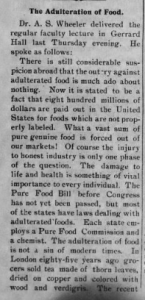
“The Adulteration of Food.” The Tar Heel, 28 Apr. 1904, http://newspapers.digitaln c.org/lccn/sn92073227/1904-04-28/ed-1/seq-2/. Accessed 1 Nov. 2018.
The source is a lecture published on April 28, 1904 in The Tar Heel, now known as The Daily Tar Heel, which serves as the University of North Carolina’s student-run newspaper. This particular lecture was given by UNC faculty member A.S. Wheeler at Gerrard Hall regarding the widespread outbreak of adulterated and improperly labeled foods in the United States. Adulteration is a term used to describe food products that fail to meet legal standards, due to being generally impure or unsafe [1]. According to the lecturer, “76 per cent of the jellies and jams bought on the open market were adulterated and every single sample of apple butter, catsup, and sauces,” and makes it obvious that the rise of adulterated foods was a grave issue at the time. This article gives insight into the mislabeling and erroneous packaging of foods during this time, giving examples of different types of ways foods are imitated and passed off as legitimate, such as adding filler ingredients or using ingredients that can emulate the flavor or texture of the real thing.
By following the climb of the adulterated food epidemic, this phenomenon also traces the rise of mass produced goods in the Progressive Era. The decreased reliance on traditional food procurement tactics, such as farming and slave labor, and increased consumer reliance on mass produced food items led to the increased food adulteration in order to cut costs and meet demand. This lecturer also assumes common knowledge of the Pure Food Bill, also known as the Pure Food and Drug Act, and explains that is has not yet been passed in the current year 1904 (though today it is known that this bill was passed in 1906) [2]. This is contextually relevant because this bill was a milestone for food safety in the United States and ended up shaping the future for consumer food protection and creating the Food and Drug Administration (FDA) [2].
It is made explicit in the lecture that the spread and implications of food adulteration was extensive throughout the country. Because this lecture was given at UNC, it is clear that this problem was also one that was affecting the lives of the students and citizens in the Chapel Hill area at the time. This source is essential in understanding the food story of Chapel Hill in this time period because it represents an era of rapid progression in commercial food distribution, one in which today’s strict laws regarding food safety and labeling had not yet been passed. This source provides a unique view in which while food security was at a historical high, food safety was not yet a given.
[1] “21 U.S. Code § 342 – Adulterated Food.” Legal Information Institute. Accessed November 01, 2018. https://www.law.cornell.edu/uscode/text/21/342.
[2] “The Pure Food and Drug Act.” US House of Representatives: History, Art & Archives. Accessed November 01, 2018. https://history.house.gov/Historical-Highlights/1901-1950/Pure-Food-and-Drug-Act/.
-Isabel Zhao
